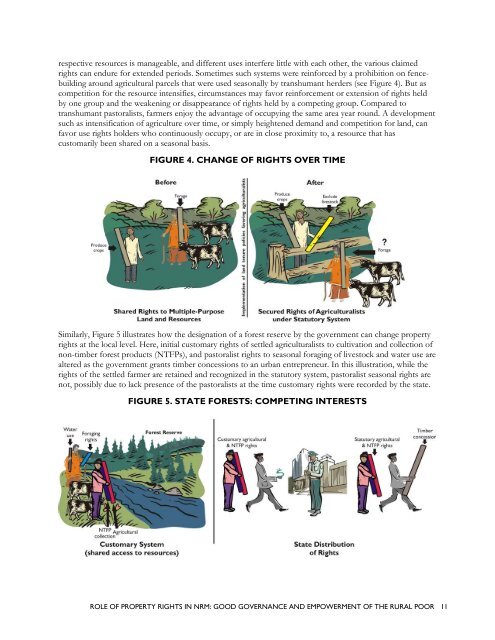the role of property rights in natural resource management, good ...
the role of property rights in natural resource management, good ...
the role of property rights in natural resource management, good ...
You also want an ePaper? Increase the reach of your titles
YUMPU automatically turns print PDFs into web optimized ePapers that Google loves.
espective <strong>resource</strong>s is manageable, and different uses <strong>in</strong>terfere little with each o<strong>the</strong>r, <strong>the</strong> various claimed<strong>rights</strong> can endure for extended periods. Sometimes such systems were re<strong>in</strong>forced by a prohibition on fencebuild<strong>in</strong>garound agricultural parcels that were used seasonally by transhumant herders (see Figure 4). But ascompetition for <strong>the</strong> <strong>resource</strong> <strong>in</strong>tensifies, circumstances may favor re<strong>in</strong>forcement or extension <strong>of</strong> <strong>rights</strong> heldby one group and <strong>the</strong> weaken<strong>in</strong>g or disappearance <strong>of</strong> <strong>rights</strong> held by a compet<strong>in</strong>g group. Compared totranshumant pastoralists, farmers enjoy <strong>the</strong> advantage <strong>of</strong> occupy<strong>in</strong>g <strong>the</strong> same area year round. A developmentsuch as <strong>in</strong>tensification <strong>of</strong> agriculture over time, or simply heightened demand and competition for land, canfavor use <strong>rights</strong> holders who cont<strong>in</strong>uously occupy, or are <strong>in</strong> close proximity to, a <strong>resource</strong> that hascustomarily been shared on a seasonal basis.FIGURE 4. CHANGE OF RIGHTS OVER TIMESimilarly, Figure 5 illustrates how <strong>the</strong> designation <strong>of</strong> a forest reserve by <strong>the</strong> government can change <strong>property</strong><strong>rights</strong> at <strong>the</strong> local level. Here, <strong>in</strong>itial customary <strong>rights</strong> <strong>of</strong> settled agriculturalists to cultivation and collection <strong>of</strong>non-timber forest products (NTFPs), and pastoralist <strong>rights</strong> to seasonal forag<strong>in</strong>g <strong>of</strong> livestock and water use arealtered as <strong>the</strong> government grants timber concessions to an urban entrepreneur. In this illustration, while <strong>the</strong><strong>rights</strong> <strong>of</strong> <strong>the</strong> settled farmer are reta<strong>in</strong>ed and recognized <strong>in</strong> <strong>the</strong> statutory system, pastoralist seasonal <strong>rights</strong> arenot, possibly due to lack presence <strong>of</strong> <strong>the</strong> pastoralists at <strong>the</strong> time customary <strong>rights</strong> were recorded by <strong>the</strong> state.FIGURE 5. STATE FORESTS: COMPETING INTERESTSROLE OF PROPERTY RIGHTS IN NRM: GOOD GOVERNANCE AND EMPOWERMENT OF THE RURAL POOR 11

















